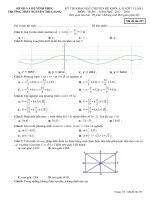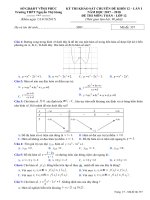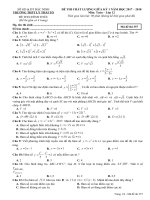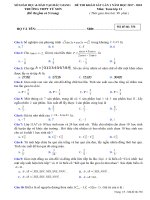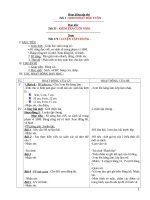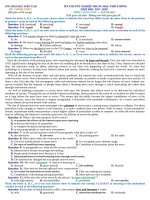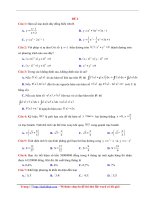Cs224W 2018 35
Bạn đang xem bản rút gọn của tài liệu. Xem và tải ngay bản đầy đủ của tài liệu tại đây (4.03 MB, 7 trang )
Network Robustness in the US Airports Infrastructure
CS224W - Project Report
Network Analytics
Paul Magon de La Villehuchet
Stanford University
Abstract
Networks are present everywhere: in our relationships, in
infrastructures, in technology and even in biology. Therefore, the analysis of networks will deeply improve our understanding of the world in which we live. Network theorists have developed several models to explain the properties of the networks surrounding us. The most renown model
is the Random Graph model developed by Paul Erdos and
Alfred Renyi. More recently, Duncan Watts and Steven Strogatz have developed a more realistic model known as SmallWorld. However, both this models, even though useful, still
lack an essential property observed in many real networks:
the degree distribution is not a nice bell curve but rather
a power-law. Networks exhibiting this property are called
scale-free networks and have been discovered recently (late
1990s). the objective of this project is to study the properties of scale-free network using an empirical graph: the US
Airports network.
Introduction
The goal of the project is to study empirically the properties
of scale-free networks using a real network based on the
airport infrastructure in the US. Specifically, the project is a
three steps process:
1. Characterize the nature of the US airports graph
2. Measure the robustness of the network
3. Derive efficient
against attacks
strategies
to
protect
the
network
In this report, we detail all the results and methods used for
every step. Related work and references are presented in the
last section
Figure 1: Scale-Free vs Random, extracted from [1]
1. Nature of the US airports graph
1.1. The data
1.1.1
Dataset motivation
In [1] article, A. Barabasi and R. Albert take the example
of the airport infrastructure versus the highway infrastructure to explain the fundamental differences between random
graphs and scale-free graphs. This prompted me to look for
airport data to work on scale-free networks and the class
website provided us with a good dataset so I decided to use
it.
1.1.2
Dataset description
The data used in this project is a network of all US-Airports.
Specifically, the network consists of a weighted edge list
containing ids between two airports and the number of seats
between the airports in 2002 (sum of the number of seats for
all flights between the two airports). Therefore, using this
data, the graph will be undirected and weighted.
1.1.3
Dataset collection
There was no data collection for this network as the dataset
is available online. Indeed, our objective here is not to ap-
[ Satie
vate]
IV
500
ply some algorithms to a new set of data but to learn about
scale-free properties on an empirical network. Furthermore,
I do like planes and airports therefore I think this data is
great to explore properties of scale-free networks.
|E|
p
Ỡ
1.2. Scale-free networks
1.2.1
Characterization
Most real-life networks are dominated by very few nodes
having
almost
unlimited
number
of connections,
called
hubs, while the vast majority of nodes have very few connections, hence the term scale-free.
Such networks are ex-
tremely present in social networks and infrastructure networks. Mathematically, these networks are characterized
by heavy-tail distribution unlike most generative models of
networks: the tail is much bigger and the nodes at the end
are statistically significant. In Random graphs and SmallWorld networks, the contribution of very node to the graph
is relatively equivalent: the distribution of the degree usually follows a bell-curve decaying exponentially with the
degree k. However, in the case of scale-free networks, the
degree distribution follows a power-law: P(k) « k~7. Em-
pirically, the exponent value, y, is between 2 and 3 and is a
key characteristic of the network.
1.2.2.
Generative mechanism
To understand why most real-life networks are scale-free,
the authors in [2] developed a generative model , preferential attachment, leading to a scale-free network. The key
idea of preferential attachment is that as the network grows,
new nodes are more likely to connect to high-degree nodes.
Specifically, the algorithm is in two steps:
Growth: start with mo nodes and at each step t add |
node with m edges.
Preferential Attachment:
with probability
ky
ke
connect edge 7 with node 2
with k; the degree of node 7.
Using this algorithm, the authors prove that the distribution
of the resulting network is P(k) « k~3
1.3. The US Airports graph
1.3.1
General statistics
In this part, we considered the unweighted version of the
graph, i.e the edges have all weights equal to 1. We will
take into consideration weighting of the edges in the next
part. The statistics we considered are: |V| the number of
nodes, |E| the number of edges, p the density of the graph
and C the average clustering coefficient.
Table 1: Summary statistics of the airport graph
2980
0.024
0.62
As can be seen, this graph 1s characterized by an extremely high clustering coefficient for a rather low density. To explore the properties of this graph, I will compare
our graph to ’gold-standard” models seen in class: ErdosRenyi, Watts-Strogatz. I will also explore the degree distribution of the graph.
1.3.2
Comparison with ”’gold-standards” models
Erdos-Renyi: The first model we can use to benchmark our
network is the random graph generator from Erdos-Renyi.
We obviously expect the graph to have different properties
as the airport graph ’should” be scale-free (more on that in
the next subsection).
Table 2: Comparison between the airport graphs and the
Erdos-Renyi model
| Statistic
Airport
Erdos-Renyi |
IV]
[|
p
G
500
2980
0.024
0.62
500
2980
0.024
0.023
As expected the properties are extremely different. We can
see the big difference in the average clustering coefficient.
This is not surprising as Erdos-Renyi graph are known to
have low clustering compared to real-world data.
Watts-Stogratz: The second model we saw in class was
the Small-World model. To generate a Small-World model
graph, we used the method seen in assignment | that consists of:
1. Start with a ring of nodes
2. Connect each node to its neighbors’s neighbors
3. Choose at random a non-connected pair of nodes and
connect them
We saw in class that there the Watts-Strogatz model is
characterized by a higher clustering coefficient than ErdosRenyi therefore we expect the statistics to be closer to one
another.
Table 3: Comparison between the airport graph and the
Watts-Strogatz model
| Statistic
Airport
Watts-Strogatz
500
2980
0.024
0.62
500
2980
0.024
0.074
VỊ
E|
p
C
|
Degree
Distribution
+—
US Aiports Graph
+—+
Random
Graph
Even though the results are better for the Watts-Strogatz
model,
the model
still does
not capture the nature
of the
Scale-Free:
fk)
airport graph. Therefore, this leads me the believe that
the nature of the airport graph will be indeed scale-free.
To try to prove this statement, we will compare the graph
with our third and last model: a scale-free model where the
parameter is the exponent of the distribution.
In the initial article, A. Barabasi and R. Albert
mentioned that most of the networks encountered in the real
world were scale-free with exponents ranging from 2 to 3.
To try to understand the airport graph, we will compare its
properties with networks generated using a power-law distribution. We decided to choose 3 values of the exponent 2:
1.5, 2,3.
Figure 2: Degree distribution
1.4.2
Table 4: Comparison between the airport graph and the
Scale-Free model
| Statistic
V
b
p
C
Airport
y=15
y=2
y=3
500
2980
0.024
0.62
500
2875
0.023
0.30
500
1331
0.011
0.19
500
489
0.0039
0.0027
|
The scale-free models give us results that are quite satisfying because all the numbers are in the right order of mag-
Exponent estimation
To estimate the exponent of the graph, we used 3 methods
seen in class.
We applied these methods to both the
weighted and the unweighted matrix.
The intuition is
that the power-law should be even more dominant in the
weighted matrix as the degree of big airports will be
inflated by the volume of traffic (number of seats).
Exponent fit: To determine the exponent of the power distribution, we fitted the degree-distribution in a log-log scale
and then fitted a linear regression. The equation we fit is:
log(P(k))
= —3log(k) + Ô
nitude. Therefore, this leads us to believe that the nature of
the airport graph is scale-free. Furthermore, from the experimentation presented above, we expect the graph to have
a low exponent as y = 1.5 got the closest results. In conclusion, the closest generative model seen in class to our
airport graph is the scale-free model. To go deeper in our
understanding of the airport graph, we will analyze its degree distribution.
This method is unreliable: the tail of the degree distribution
is messy as can be seen been in Figure 3.
CCDF: The second method we used was to fit a linear regression on the Complimentary CDF. Specifically, we com-
pute P(deg > k) Vk and then fit a linear regression on this
distribution. The equation we fit is:
1.4. Degree characterization
1.4.1
Degree distribution
The degree distribution is the key characteristic of scalefree networks. Figure 2 represents the degree distribution
of the US Airports graph along the degree distribution of
some generated Erdos-Renyi graph. As we can see, the
nature of the distribution is completely different for both
models and the intuition that the airport follows a powerdistribution seems confirmed.
log(P(deg
> k)) = —+ log(k) + Ô
The value of the fitted coefficient + verifies Y =1+%.
The interesting learning from this method is that even
though the degree distribution is characterized by a heavy
tail, a power law does not seem to fit perfectly as we can
see that the CCDF is not a straight line in a log-log scale.
Maximum
Likelihood
method
used
we
was
Estimation:
the maximum
Finally,
likelihood
the
last
estimator.
Log-Log Degree
+
|
Distribution
Data Points
+
Method
Table 5: Exponent Estimation
Weighted matrix
Unweighted matrix
Exponent fit
CCDF
MLE
Fitted Linear Regression, a = -1.372, b = 4.351
1.372
2.25
1.64
|
0.993
1.96
1.15
1.5. Conclusion
Sk)
We can draw 3 main learnings from this first part: first,
the US Aiport graph is indeed characterized by a heavytail distribution.
1
0.0
05
1.0
15
2.0
log(k)
25
3.0
35
4.0
Figure 3: Fitted linear regression on the degree distribution
Second,
we can see that this distribution
does not seem to be completely scale-free as the plot of the
CCDF shows some non-linearity in the log-log scale. Third,
we can compute estimates of the exponent of the distribution. As was expected, those exponents are higher with the
weighted matrix and are conform to empirical results from
other scale-free networks (at least using the CCDF estimator, we find that y is between 2 and 3). With this characterization done, we can move to the second part of the project
where we will study the properties of robustness.
2. Network Robustness
2.1. General scheme
Log-Log CCDF
+
‘+
Distribution
Data Points
Fitted Linear Regression, a = -1.25, b = 1.636
The goal of this part is to measure network robustness. Network robustness is an extremely important characteristic for
infrastructure networks (and networks in general).
Indeed,
in big networks, nodes will eventually fail and thus impact
the network as a whole. Knowing how robust and vulnerable is the network to such failures is key in protecting it.
More precisely, in this part, we define two types of failures: first, random failures simulate random defects in the
network. For instance, in the case of airports, that could
Iog(E)
Figure 4: Fitted linear regression on the CCDF
be one airport being closed due to a an unexpected storm.
Second, attacks simulate targeted attacks against the network with the objective of destroying the network. In the
case of airports, that would be targeted attacks (by a malicious entity such as a rogue state) against specific airports
to undermine the functioning of the US airport system as a
whole. To measure robustness, I used the the relative size of
the biggest connected component. The process to measure
robustness was the following:
1. Choose some ordering of the nodes, relevant to the
type of failure.
Assuming the minimum
estimator is given by:
value of the degree to be 1, the
YMLE=1+-,
with d;, degree of node i
», log(d;)
The following table summarizes the different estimations of
the exponent.
2. Eliminate nodes according to the ordering and measure the relative size of the biggest component at each
iteration.
For random failures, the ordering I chose was simple: just
pick nodes at random. For attacks, I decided to use centrality as an ordering of the nodes. The next part details which
centrality measures were used. Finally, we repeated this
procedure on the airport graph and on a generated ErdosRenyi (used a benchmark).
Log-Log Centrality vs Degree
Erdos-Renyi
Failures
Airports Failures
Erdos-Renyi
Attacks
Airports Attacks
log(c(k))
Size of the Biggest Connected Component
0.8
0.2
“0.0
log(d(k))
Figure 5: Correlation between harmonic centrality and degree
2.2. Measure of centrality
I used three measures of centrality, c, to determine which
nodes to attack
1. Degree of the node: c; = deg(i). This simple measure
is extremely effective to compute and powerful in the
case of scale-free networks.
2. Harmonic centrality: c; = »
—
TZ Ui, 5)
with đ(¿, 7) the
shortest path between 7 and 7. Harmonic centrality
measures how much nodes need to rely on other nodes
to convey information. Unsurprisingly, harmonic centrality is strongly correlated with the degree.
‘
:
3. Eigenvector centrality:
c; =
1
—
`
:
c; Eigenvector
Œ,2)€E
centrality measures the influence of a node in the network.
2.3. Results: Airports vs Random graphs
In this first subsection, we only compare the result of failures of the network to failures in our benchmark graph. Furthermore, to simulate attacks, we used the degree measure
as this is the most obvious measure.
The results from this experiment are both conform to intuition on the behavior of each graph: the Erdos-Renyi is
sensitive in a similar way to both attacks and failures with
attacks being slightly more effective. On the other end, the
01
0.2
0.3
0.4
0.5
Proportion of nodes removed
0.6
0.7
0.8
0.9
Figure 6: Robustness of the network
airport graph is quite insensitive to failures while being extremely sensitive to attacks. These behaviors are not surprising and follow the results in [2]. However, I was expecting the airport graph to be more robust against failures than
the Erdos-Renyi graph and the graph shows that in both case
the Erdos-Renyi is strictly superior. A few elements can
help us understand this discrepancy: first of all, the rather
small number of nodes can be an explanation.
Second, the
robustness metric used is the size of the biggest connected
component. Other metrics are also used to measure network
robustness.
2.4. Results: Impact of Centrality on Robustness
In this subsection, we assess the impact of centrality on the
robustness of the network. As we can see in Figure 7, the
results are quite conform to intuition. First, all metrics measure how important and central is a node therefore the scalefree network is extremely sensitive to attacks. Furthermore
because of the high correlation between the harmonic centrality and the degree (Figure 5), the results are extremely
similar in both cases. Finally, the eigenvector centrality is
slightly different than the other two as it emasures the number of paths of infinite length hence smoothing the sharpness of the degree distribution, it is closer to the random
failures scheme.
2.5. Conclusion
In conclusion, centrality plays a key role in the robustness
of the network: scale-free networks are particularly sensitive to targeted attacks against the network and centrality
both provides the optimal strategy to attack the network and
10
7
=—«
Airports Failures
ma
Erdos-Renyi
e—e
Airports Attacks - Degree
e—e
Airports - No Immunization
—
Airports Attacks - Harmonic Centrality
—
Airports Attacks - Random
+
Airports Attacks - Eigenvector Centrality
+
Airports Attacks - Degree
Immunization
Immunization
25
2a
Proportion of infected nodes
Size of the Biggest Connected Component
0.8
0.2
0.0
0.1
0.2
0.3
0.4
0.5
Proportion of nodes removed
0.6
0.7
0.8
0.9
Figure 7: Robustness of the network
to defend it.
Furthermore,
our results show
that the sim-
pler measure of centrality, i.e the degree if the network is
the most effective. This is not really surprising since the robustness metric we used is the size if the biggest component
therefore it is extremely sensitive to hubs: removing them
will cause the network to be segmented hence explaining
the results. To go further in our understanding of the network robustness and centrality, I decided to simulate the
propagation of an epidemic in the network in the last part.
3. Efficient strategies against attacks
3.1. General scheme
In the last part, we determined that network centrality plays
a key role in network robustness and is therefore the key to
deriving efficient strategies to protect networks. To understand how these concepts are linked, I decided to simulate
the propagation of an epidemic on the US Airports graph.
The epidemic process was the following:
1. Start by infecting 7 nodes
2. At each step, every node infects its neighbors with
some probability q
We decided to test the model against three strategies:
1. No immunization
2. Immunize 7 nodes at random
3. Immunize 7 nodes based on the degree
0.0
0
5
10
Number of iterations
15
20
Figure 8: Propagation of the epidemy
3.2. Results
In the above simulation, we chose t = 5%. Moreover, we
did not count immunized nodes when computing the proportion of infected nodes. The results of this experiment
are conform to our intuition. First of all, the scale-free graph
converges to full epidemic much faster than a random graph
used as a benchmark.
Furthermore, as with failures, target-
ing the highest degree nodes is the most effective strategy
to protect the network since it reduces considerably the time
to reach full contagion.
3.3. Conclusion
In conclusion, our most efficient strategy will simply be to
protect the most connected nodes. One element that can
be added is that in the case for which the graph is too big to
compute the entire degree distribution (such as the Internet),
one efficient way to determine the most connected nodes
is simply to use random walks starting at random as these
random walks will most likely end-up on highly connected
nodes.
4. Conclusion
The goal of the project was to study the properties of
the scale-free networks using an empirical dataset, the US
Aiports dataset. I first studied the property of this dataset
and found that it has indeed the properties of scale-free
graphs even though its distribution is not perfectly a powerdistribution. In a second part, I studied the robustness of the
network using various measures of centrality to determine
efficient ways to attack the network. Using these results,
I derived efficient strategies to protect the network against
attacks. Even though I was not able to to do everything I
hoped for, I enjoyed working in this project and enjoy the
class in general.
5. Related work - Contributions
Being alone, I worked on everything myself.
Related work:
e A. Barabasi, and E. Bonabeau.
Scale-Free Networks.
Scientific American (2003)
In this paper, the authors develop a new model of networks,
scale-free
networks.
Most
real-life networks
are dominated by very few nodes having almost unlimited number of connections, called hubs, while the vast
majority of nodes have very few connections, hence
the term scale-free.
e R. Albert, and A. Barabasi.
Statistical Mechanics of
complex networks. Review of Modern Physics (2002)
In this comprehensive paper, the authors address all
the shortcomings of the first paper and lay-out all the
mathematical theory underlying scale-free graphs. It
was extremely helpful to understand the theory underlying scale-free networks.
e R. Albert,
and A. Barabasi.
Error and attack toler-
ance of complex networks. Review of Modern Nature
(2000)
The authors of this paper develop some tools to measure the robustness of the scale-free networks to failures and attacks. Specifically, robustness was measured for scale-free networks and benchmarked against
Random Graphs. This paper was extremely helpful for
the second part of the project when studying properties
of centrality and robustness.
e CS224W Lectures notes
L used a lot the lecture notes in my project, especially
for centrality and scale-free characterization. It would
be unfair not to mention it.
6. References
[1] A. Barabasi, and E. Bonabeau.
Scientific American (2003)
{2] R. Albert,
and A. Barabasi.
Scale-Free Networks.
Statistical Mechanics
of
complex networks. Review of Modern Physics (2002)
[3] R. Albert, and A. Barabasi.
Error and attack tolerance
of complex networks. Review of Modern Nature (2000)


